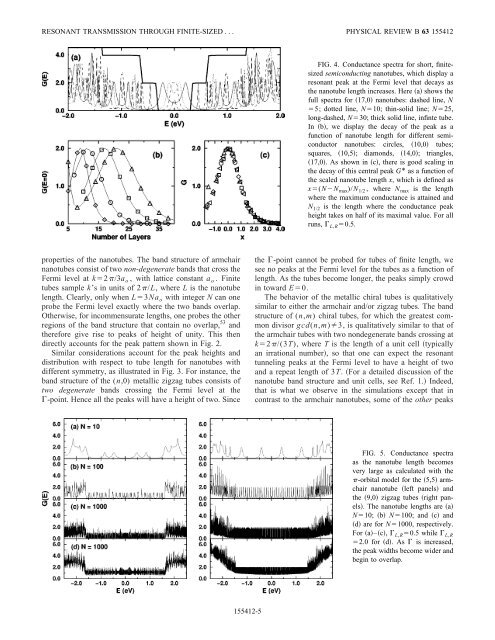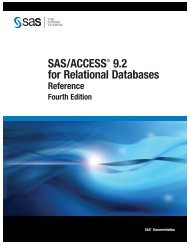using standard prb s - The Department of Physics and Astronomy
using standard prb s - The Department of Physics and Astronomy
using standard prb s - The Department of Physics and Astronomy
Create successful ePaper yourself
Turn your PDF publications into a flip-book with our unique Google optimized e-Paper software.
RESONANT TRANSMISSION THROUGH FINITE-SIZED . . . PHYSICAL REVIEW B 63 155412FIG. 4. Conductance spectra for short, finitesizedsemiconducting nanotubes, which display aresonant peak at the Fermi level that decays asthe nanotube length increases. Here a shows thefull spectra for 17,0 nanotubes: dashed line, N5; dotted line, N10; thin-solid line; N25,long-dashed, N30; thick solid line, infinte tube.In b, we display the decay <strong>of</strong> the peak as afunction <strong>of</strong> nanotube length for different semiconductornanotubes: circles, 10,0 tubes;squares, 10,5; diamonds, 14,0; triangles,17,0. As shown in c, there is good scaling inthe decay <strong>of</strong> this central peak G* as a function <strong>of</strong>the scaled nanotube length x, which is defined asx(NN max )/N 1/2 , where N max is the lengthwhere the maximum conductance is attained <strong>and</strong>N 1/2 is the length where the conductance peakheight takes on half <strong>of</strong> its maximal value. For allruns, L,R 0.5.properties <strong>of</strong> the nanotubes. <strong>The</strong> b<strong>and</strong> structure <strong>of</strong> armchairnanotubes consist <strong>of</strong> two non-degenerate b<strong>and</strong>s that cross theFermi level at k2/3a o , with lattice constant a o . Finitetubes sample k’s in units <strong>of</strong> 2/L, where L is the nanotubelength. Clearly, only when L3Na o with integer N can oneprobe the Fermi level exactly where the two b<strong>and</strong>s overlap.Otherwise, for incommensurate lengths, one probes the otherregions <strong>of</strong> the b<strong>and</strong> structure that contain no overlap, 53 <strong>and</strong>therefore give rise to peaks <strong>of</strong> height <strong>of</strong> unity. This thendirectly accounts for the peak pattern shown in Fig. 2.Similar considerations account for the peak heights <strong>and</strong>distribution with respect to tube length for nanotubes withdifferent symmetry, as illustrated in Fig. 3. For instance, theb<strong>and</strong> structure <strong>of</strong> the (n,0) metallic zigzag tubes consists <strong>of</strong>two degenerate b<strong>and</strong>s crossing the Fermi level at the-point. Hence all the peaks will have a height <strong>of</strong> two. Sincethe -point cannot be probed for tubes <strong>of</strong> finite length, wesee no peaks at the Fermi level for the tubes as a function <strong>of</strong>length. As the tubes become longer, the peaks simply crowdin toward E0.<strong>The</strong> behavior <strong>of</strong> the metallic chiral tubes is qualitativelysimilar to either the armchair <strong>and</strong>/or zigzag tubes. <strong>The</strong> b<strong>and</strong>structure <strong>of</strong> (n,m) chiral tubes, for which the greatest commondivisor gcd(n,m)3, is qualitatively similar to that <strong>of</strong>the armchair tubes with two nondegenerate b<strong>and</strong>s crossing atk2/(3T), where T is the length <strong>of</strong> a unit cell typicallyan irrational number, so that one can expect the resonanttunneling peaks at the Fermi level to have a height <strong>of</strong> two<strong>and</strong> a repeat length <strong>of</strong> 3T. For a detailed discussion <strong>of</strong> thenanotube b<strong>and</strong> structure <strong>and</strong> unit cells, see Ref. 1. Indeed,that is what we observe in the simulations except that incontrast to the armchair nanotubes, some <strong>of</strong> the other peaksFIG. 5. Conductance spectraas the nanotube length becomesvery large as calculated with the-orbital model for the 5,5 armchairnanotube left panels <strong>and</strong>the 9,0 zigzag tubes right panels.<strong>The</strong> nanotube lengths are aN10; b N100; <strong>and</strong> c <strong>and</strong>d are for N1000, respectively.For a–c, L,R 0.5 while L,R2.0 for d. As is increased,the peak widths become wider <strong>and</strong>begin to overlap.155412-5
















